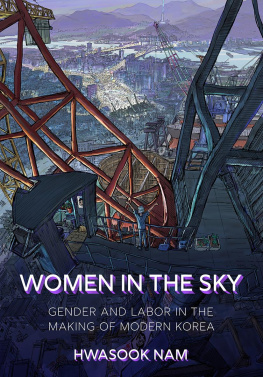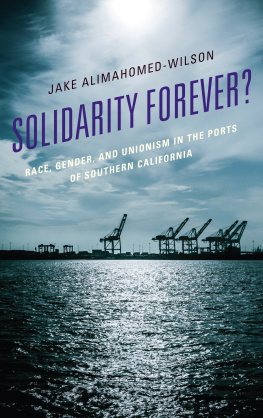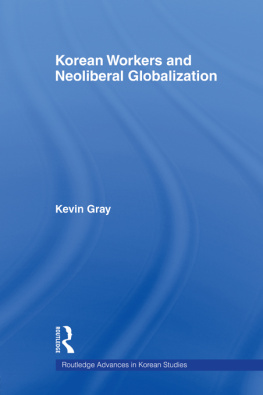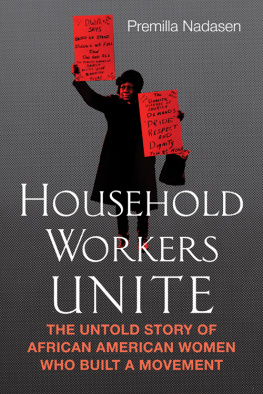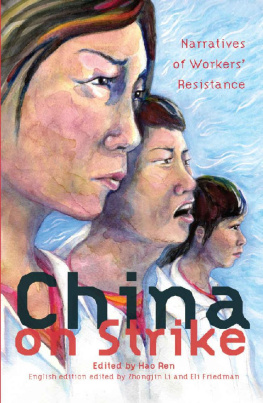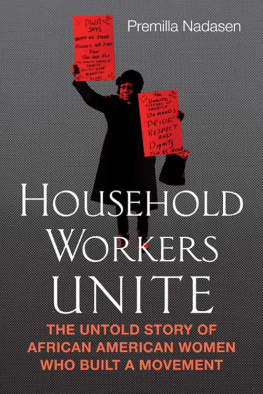Acknowledgments
From the time I began my graduate study in history at the University of Washington (UW) in Seattle in the 1990s, my aspiration has been to write a book focusing on labor and gender to illuminate the turbulent twentieth-century history of Korea. In particular, I dreamed of composing a book in which women workers as protagonists guide readers through modern Koreas important historical moments and thereby facilitate a new way of seeing the countrys political and economic history. This rather ambitious goal has shaped my academic career as a whole and defined my choice of research topics for the past two decades. I first studied male shipbuilding workers, writing a PhD dissertation on their activism, and I later published a book on the subject, first in English in 2009 and then in Korean translation in 2014. In subsequent years I continued to pursue research on various aspects of the history of the South Korean labor movement, looking into gender dynamics in particular, which resulted in several articles and book chapters on the subject. Over the years I accumulated many boxes of source materials on women worker activism through archival research, and I wrote versions of several draft chapters. But it was only after I opted to retire early from my teaching job in 2018 that I was finally able to devote my full time and attention to the book and compose the whole manuscript from beginning to end.
The high point of my research for the book and a major push toward completing it came in the spring of 2017, when I invited to Seattle two incredible female labor activists from Korea, Kim Jin-Sook and Hwang Yira, and organized a series of events around them. The support for their visit came from various entities, including the UWs Harry Bridges Center for Labor Studies, Department of History, and Center for Korea Studies. Support also came from the local Korean community and Seattle unionists. I had had previous contact with Kim, having first chronicled her central role in the democratization in the 1980s of the union at the Hanjin shipyard in Pusan, and later during several interviews I did with her in 2004 and 2006. But her Seattle visit offered me a precious chance to observe her, a key protagonist in this book, up close in public and private settings and talk with her at length. Kim Jin-Sook and her comrade Hwang Yira created many inspiring moments for event attendees, including myself, and the experience of watching them interacting with local unionists and Korean community people as well as students increased my resolve and sense of urgency to get on with this book project.
A particular encounter with Kim Jin-Sook became seared into my memory and has affected the way I composed this book. During a workshop held on campus, Kim, who as a guest had been sitting in a corner of the room patiently listening to scholarly discussions, raised her hand and made a short but impactful observation. She said that while she could see that people were talking about her, she had no clue what the panelists, including me, were actually saying about her. I interpreted her comment as a protest arising from a deep suspicion toward highly educated elite intellectuals who, while professing sympathy to labors causes, tend to work in a language that is difficult to access for workers like her. The memory of that moment has haunted me and forced me to continue asking who I am vis--vis Kim and other women workers whose lives and actions I discuss in the book. Mindful of the distance and complex power relations between intellectuals and workers in the South Korean labor movement, an issue broached in several chapters of the book, I have taken pains to contemplate my own perceptions and interpretations. I have also endeavored to make the book as readable as possible in the hope that Kim and Hwang, and other women workers, will one day read the book in Korean translation and express their own critical views of the book and its subjects.
I received help from numerous individuals and institutions during the many years this book was evolving. Teaching Korean and labor history, first at the University of Utah and then at the UW, afforded me the opportunity to advance my understanding of the issues covered in the book through innumerable helpful discussions with students and colleagues at those institutions. After joining the UW faculty in 2007, I received occasional support for this project from the UWs Department of History and Center for Korea Studies. Major financial support came in the form of a visiting professorship during the fall semester of 2011 from the Graduate School of East Asian Studies (GSEAS) of Yamaguchi University in Japan, at which time, while teaching labor history classes in English, I observed from afar the last leg of Kim Jin-Sooks historic crane-top sit-in. I thank the GSEAS and Professor Yokota Nobuko for hosting me and also arranging for me to give a public lecture at the university. That lecture represented my first attempt at linking Kim Jin-Sook and her 1930s predecessor, Kang Churyong, in the context of the unusual phenomenon of the high-altitude sit-in struggles South Korea was witnessing at the time. A year-long sabbatical leave from the UW during the 201516 academic year and a visiting professorship offered by the Department of History at Sungkyunkwan University in Seoul in the fall semester of 2015 allowed me to conduct more research at libraries and archives in Seoul and Daejeon. During that time, I benefited from the extensive collections on Korean social history at the Sungkyunkwan University Library, the Seoul National University Library, the National Library of Korea, the National Assembly Library, and the National Archives of Korea. I am grateful to professors Ha Wonsoo and Chung Hyunback, my hosts at Sungkyunkwan, for that opportunity. I also benefited from the oral history and documentary collections held at the Labor History Institute of Snggonghoe University and at the Korea Democracy Foundation.
Kim Keong-il of the Academy of Korean Studies kindly helped me digitally access the Snggonghoe University oral history materials as well as colonial-period source materials, and Yi Sanggyng of KAIST University always offered ready answers to the many questions I peppered her with regarding colonial-period Korean literature and gender history. Womens historian Lee Namhee, then head of the Korean Womens Studies Institute, arranged for Kim Jin-Sooks special lecture for the Womens Studies Interdisciplinary Program at Seoul National University in September 2017 and shared the transcript of the lecture with me. I am grateful to these and many other scholars in Korea who have welcomed me into their research circles and made my research work in Korea an enriching and enjoyable experience. As always, outstanding holdings of Korean-language materials at the East Asia Library at the University of Washington and its offering of database access to source materials and publications in Korea have been indispensable for my research. I thank in particular the librarys Korea librarian, Yi Hyokyoung, for all her support over the years.
Studying labor history alerted me to the important role Cornell University Press has played through publication of its many books on labor and gender, including studies of the South Korean labor movement. I am grateful to editors Frances Benson, Ellen Labbate, and Jennifer Savran Kelly for their encouragement, guidance, and support through the review and publication process. The book benefited greatly from the sharp comments and very useful suggestions offered by the two anonymous readers of the initial manuscript.

